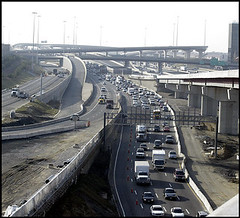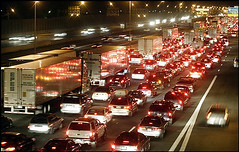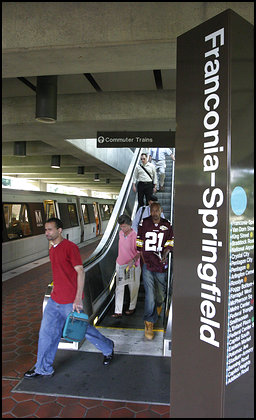Examiner Editorial gets it wrong: Choosing cars over transit
 Photo: Kevin Clark, The Washington Post. The exit to the left of the picture is the newly a completed bridge as part of the mixing Springfield Mixing Bowl Project in Springfield.
Photo: Kevin Clark, The Washington Post. The exit to the left of the picture is the newly a completed bridge as part of the mixing Springfield Mixing Bowl Project in Springfield. The Examiner editorial yesterday, "Don’t give Metro the ‘largest earmark in history’" writing against providing federal monies to upgrade the WMATA subway reflects the paper's general political orientation (I mean, have you ever managed to read a complete column by Jay Ambrose?)--which doesn't leak into the news coverage--but doesn't properly reflect the situation or history.
First, I have argued for many years that extra-normal federal support for the Washington region's transit system and further development should be considered, in part, a form of reparations, because Congress, in either a fit of pique or because of lobbying from GM and the oil and tire industries all eager to sell more buses, through the passage of a law, forced the Capital Transit system to abandon streetcars.
Well, shouldn't the Federal Government take responsibility for that decision, and pay for their foolishness and pigheadedness (the new owner of the Capital Transit system lobbied to no avail to get Congress to change its decision), and rebuild what they ordered, for no good reason, destroyed?
Granted, from the 1920s to the 1950s (with the exception of WWII) streetcar usage was on the decline because of the triple whammy of the rise of the personally owned automobile, then the depression, and all through this period, with a torrent after WWII, suburban outmigration.
This was complicated further by over-regulation which kept fares down, reducing the ability of transit systems to invest in the system, and also by not having enough streetcars leading some lines (like the 10/12 Line on H Street) to be abandoned in favor of buses, with the streetcars being diverted to other lines, or new streetcars costing too much in the face of huge economic demand for all sorts of materials in the post-WWII economic boom.
Even so, some streetcar and streetcar-like systems managed to remain in operation during this period, and do so still--SEPTA in Philadelphia, Chicago Transity Authority, the T in Boston, the streetcars in Toronto, of course San Francisco and New Orleans, etc.--so it is reasonable to assert that had Congress not ordered the destruction of the Capital Transit streetcar system, it would have remained operating and could have been in operation even today. (For decades afterwards, many of the streetcars abandoned by the U.S. continued to operate in other parts of the world.)
Second, because of the abandonment of the streetcar system and the cost of rebuilding, from scratch, a new system, the financial costs involved in buying more cars to meet demand today, and the way the "new" subway system was designed, with only two tracks, this does lead to problems. The Examiner writes:
Even Metro acknowledged during that June crisis that it is of dubious value in moving the federal work force to and from work, noting that “delays could be less severe if large numbers of them take advantage of the unscheduled leave option and stay home.”
Now, the Examiner uses this problem to justify not providing additional monies, rather than using the same point to justify why additional monies are needed.
Furthermore, the paper's political agenda clearly results in the writing of this third paragraph, because I read the Examiner pretty closely and I haven't read any articles in it that support this point. Additionally, while I can't claim to be super knowledgeable about the ins and outs of the operations of all transit systems across the country, few examples come to mind where private contractors are running heavy and light rail transit systems. They write:
Here’s a better idea: Stop subsidizing the waste and mismanagement inherent in an obsolete 1950s mass transportation concept, and force Metro to cut costs, become more efficient and undertake a crash course to learn how transit systems around the country are using competitive contracting to ease burdens on taxpayers while improving service to customers.
One of the best examples of the failure of privatization in transit is with the railroads in Britain. Compare the cost of a same length train ride in Britain to one provided by the state-owned SNCF railroad in France, and you'll find that not only is the French train much faster, it's one-third the cost! See this blog entry from January, "U.S. Federal Rail Policy: Learning from Worse Practices," for more.
Plus more claptrap:
Since fewer than 1-in-10 Washington region commuters use Metro, approval of the Davis proposal would create the same inequity at the local level as the federal level. Middle- and lower-middle class taxpayers would be forced to subsidize commuting costs of much more affluent Metro riders.
 April 13, 2006. Rich Lipski, Washington Post. From the Springfield mixing bowl area looking southbound on I-95, leaving the beltway toward Richmond, traffic is moving slowly due to an earlier accident further south on I-95. Top portion of picture shows traffic moving nouthbound toward the Washington beltway.
April 13, 2006. Rich Lipski, Washington Post. From the Springfield mixing bowl area looking southbound on I-95, leaving the beltway toward Richmond, traffic is moving slowly due to an earlier accident further south on I-95. Top portion of picture shows traffic moving nouthbound toward the Washington beltway. This is misleading for a couple reasons. One is that if you add 200,000-300,000 additional cars to the regional road system Monday through Friday, you're likely to have issues... (based on a number of 700,000 riders, presuming back and forth trips). Two, despite the paper's seeming concern for middle and lower-income taxpayers, the fact is that those of us who fall into those income categories are far more likely to use transit than the affluent people...
Now, I am a big newspaper reader. I love newspapers. And I think having the Examiner is a good thing. We get more coverage of local issues and this "encourages" the dominant paper (The Washington Post) to cover more local issues than it might otherwise.
But we have to remember that the Examiner is really the Suburban Journal newspapers, based in Virginia (I suppose I could take a photo of their name on the building at the northeast corner of 15th and K Streets NW) but re-badged as the "Washington" Examiner in order to be better positioned to sell advertising to national accounts as well as larger regional accounts.
Two or three pages of stories on Washington does not necessarily a Washington paper make.
Now, the paper today has another anti-editorial, with the take that this will increase local taxes (presumably sales taxes) "The Metro tax, brought to you by Davis, Moran, Van Hollen, Wolf, Wynn," which to be fair is somewhat accurate although not likely to be a significant burden.
Where is the editorial about why gasoline excise taxes need to be raised, because drivers pay, through gasoline taxes and car registration fees, only 50% of the cost of roads?*
My taxes are a lot higher because of this. I use transit, I ride a bike. So say that 20% of the cost of roads should be allocated to the need to move goods and services as well as for other uses, such as bicycling and walking (although maybe this is 1% of road use), and storage for cars (the average center city devotes upwards of 15% of its public space to car parking in neighborhoods and commercial districts, which is yet another subsidy to drivers).
That's still a gap of 30%!
Where's the outrage about this, Examiner editorial page, the concern for the high taxes paid by lower- and middle-income wage earners? Or would that get in the way of selling advertising for your Friday newspaper section called "Wheels"?
The billions of dollars spent on the Springfield Mixing Bowl or the Wilson Bridge reconstruction (which to speak about newspapers, the drawbridge is required in part to accommodate the Washington Post's Robinson Terminal Company and their receipt of big rolls of newsprint--couldn't they have been persuaded to move this terminal on the other side of the bridge?, would that have been cheaper?), the coming Inter County Connector... all those projects are about choices, choices that are mostly about the primacy of the car, and not well thought out in terms of long term costs, maintenance, and induced demand.
Where's that editorial? I'm waiting for it (as well as for the Examiner to add a columnist to balance Jay Ambrose).
*see this Brookings Institution report for the data: Improving Efficiency and Equity in Transportation Finance
_____
Today's Examiner also has two Letters to the Editor in favor of the funding, as well as this article, "House leader defends $1.5 billion for transportation." Now this earmark would help millions more people (and it's over 10 years, not a one-year expense) than the almost $300 million going to Alaska for the bridge to the island with 300 residents.
But unlike Eileen McNamara's column in the Boston Globe, the Examiner doesn't seem ready to "Put transit on [the] agenda" or to learn other lessons from the Big Dig and the over-reliance on the car.
HOWEVER, in defense of the Examiner, I will say that:
1. They run a lot of articles about transit in the area (many by Mike Rupert), both about WMATA and other issues, such as the Purple Line proposal in Montgomery and Prince George's County.
2. They run a 5 day/week column on mobility issues by Steve Eldridge, in a column called "Sprawl and Crawl". If you click on today's column, "Gas prices are changing, but our driving habits aren’t following suit" you get links to the last two weeks worth of columns**
3. One of Steve's columns mentioned this blog and this entry "Use it or lose it or you have to recreate it (U.S. streetcar technology and expertise)."
4. Which might just be proof once again that newspaper editorial pages often run a much different temperature than the news pages. (See my many criticisms of the Washington Post editorial page, such as this: "The Washington Post is resolute: another editorial about DC issues from a suburban perspective (baseball).")
** Before the Examiner's recent web redesign they had a "columnists" tab that you could click on (and link to) that archived a couple months worth of writing. I think this particular change wasn't a good one...
 James Thresher, Washington Post.
James Thresher, Washington Post.Index Keywords: transit



0 Comments:
Post a Comment
<< Home